Scientific classification
Kingdom:
Phylum:
Annelida
Class:
Polychaeta
Order:
Sabellida
Family:
Sabellidae
Genus:
Bispira
Species:
B. Viola
Bispira Viola
Binomial name




Bispira Viola
Bispira Viola
Bispira Viola
Bispira Viola
Bispira Viola
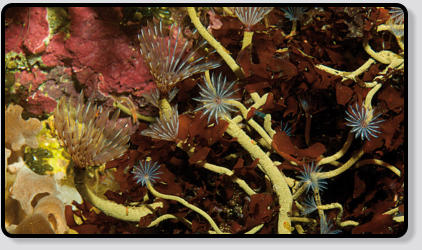
Description
Bispira viola is a brush worm of the family Sabellidae. The body of the worm consists of a head, a cylindrical, segmented body and a tail piece.
The header consists of a prostomium (section for the mouth opening) and a peristomium (portion around the mouth) and bear paired
appendages (antennae, palps and cirri).
Bispira viola in 1863 was first described by Grube.
No further information available on Wikipedia.

Animalia
Scientific classification
Kingdom:
Phylum:
Echiura
Class:
Echiuroidea
Order:
Bonelliida
Family:
Bonelliidae
Genus:
Bonellia
Species:
B. Virdis
Binomial name (link Wikipedia)




Bonellia
Bonélie
Bonellia
Bonelia
Groene Egelworm
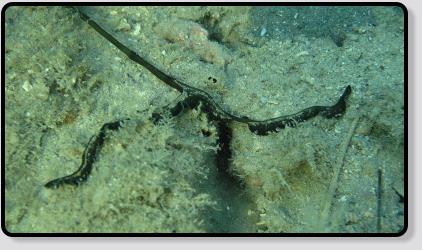
Description
Bonellia viridis, the green spoonworm, is a marine worm (Class Echiura, phylum Annelida) noted for displaying exceptional sexual dimorphism
and for the biocidal properties of a pigment in its skin.
The pale- to dark-green female, with a 15 cm-long, round or sausage-shaped body, lives on the sea-floor at a depth of 10 to 100 metres,
concealed by burrowing in gravel or hiding in rock crevasses or burrows abandoned by other animals. It has two anchoring hooks underneath its
body and an extensible feeding proboscis up to 10 times its body-length. It is mainly a detritivore, feeding also on small animals. The male is
rarely observed: it has a flat, unpigmented body which grows to only 1–3 mm, taken up mostly by reproductive organs and devoid of other
structures; it lives on or inside the body of a female.
The species is wide-ranging, found in the north-eastern Atlantic Ocean, Indian and Pacific Oceans, and the Mediterranean and Red seas.
Animalia
Scientific classification
Kingdom:
Phylum:
Mollusca
Class:
Polyplacophora
Order:
Na.
Family:
Na.
Genus:
Chiton
Species:
C. cf Canariensis
Chiton cf. Canariensis
Binomial name




Chiron
Chiton
Kanarische Käferschecke
Quitón
Keverslak
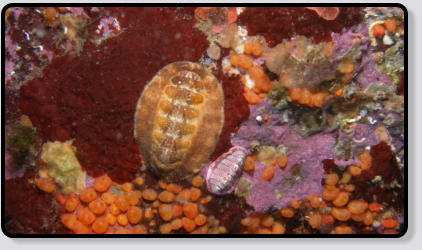
Description
This is not a wurm, but should be on this page.
Chitons /ˈkaɪtənz/ are marine molluscs of varying size in the class Polyplacophora, formerly known as Amphineura. About 940 extant and 430
fossil species are recognized.
They are also sometimes known as sea cradles or "coat-of-mail shells", or more formally as loricates, polyplacophorans, and occasionally as
polyplacophores.
Chitons have a shell composed of eight separate shell plates or valves. These plates overlap slightly at the front and back edges, and yet
articulate well with one another. Because of this, the shell provides protection at the same time as permitting the chiton to flex upward when
needed for locomotion over uneven surfaces, and even allows the animal to curl up into a ball when dislodged from rocks. The shell plates are
encircled by a skirt known as a girdle.
Animalia
Scientific classification
Kingdom:
Phylum:
Annelida
Class:
Polychaeta
Order:
Amphinomida
Family:
Amphinomidae
Genus:
Hermodice
Species:
H. Carunculata
Binomial name (link Wikipedia)




Fire Worm
Ver De Feu
Feuerwurm
Gusano De Fuego
Vuurworm
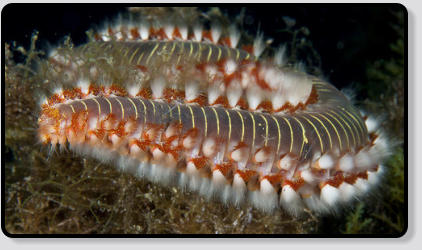
The bearded fireworm (Hermodice carunculata) is a type of marine bristleworm belonging to the Amphinomidae family, native to the tropical
Atlantic Ocean and the Mediterranean Sea.
Bearded fireworms are usually 15 centimetres in average length, but can reach up to 30 centimetres.
At first glance, this fire worm looks like a centipede with its elongated and flattened appearance, multiple segments, white silks, and parapodia
and gills located on the side of its body. Its colors are varied and range from greenish, to yellowish, to reddish, grayish through white with a pearly
glow. The body consists of 60 to 150 identical segments separated from each other by a thin white line and protected by cuticles.[1] Each
segment has a pair of parapodia, a structure for locomotion, clusters of stinging white bristles, and red or orange gills all in bilateral position. The
anterior part of the worm can be recognized by small growths, called caruncle, which have the same color of the gills on the first four segments.
The mouth is ventral and is located on the second segment. The head is shown on the first segment and includes the eyes and other sensory
organs.
The bearded fireworm lives throughout the tropical coastal waters of the Atlantic Ocean. On the eastern side they are found from Algeria to
Liberia, and on the western side from the southeast coast of the United States of America to Guyana, including the Gulf of Mexico and the
Caribbean Sea. They are also found in the eastern area of the Mediterranean Sea around the Maltese archipelago and near an island Mamula in
Montenegro.This fireworm is found in many marine living environments such as corals, rocks, mud, sand, posidonia, and on drifting wood as well
as port infrastructure in shallow water from the surface to 40 meters deep.
Description
Animalia
Scientific classification
Kingdom:
Phylum:
Annelida
Class:
Polychaeta
Order:
Sabellida
Family:
Sabellariidae
Genus:
Lygdamis
Species:
L. Wirtzi
Lygdamis Wirtzi
Binomial name




Lygdamis Wirtzi
Lygdamis Wirtzi
Lygdamis Wirtzi
Gusano Del Diablo
Lygdamis Wirtzi
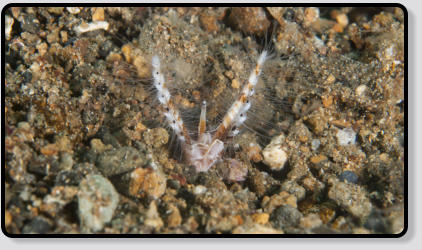
Lygdamis wirtzi is a worm of the family Sabellariidae brush. The body of the worm consists of a head, a cylindrical, segmented body and a tail
piece. The header consists of a prostomium (section for the mouth opening) and a peristomium (portion around the mouth) and bear paired
appendages (antennae, palps and cirri).
Wirtzi lygdamis was in 1999 for the first time described by Nishi & Nunez.
No further information available on Wikipedia.
Description
Animalia
Scientific classification
Kingdom:
Phylum:
Annelida
Class:
Polychaeta
Order:
Sabellida
Family:
Sabellidae
Genus:
Sabella
Species:
S. Spallanzanii
Binomial name (link Wikipedia)




Peacock Worm
Spirographe
Pfauenfederwurm
Espirógrafo
Pauwworm
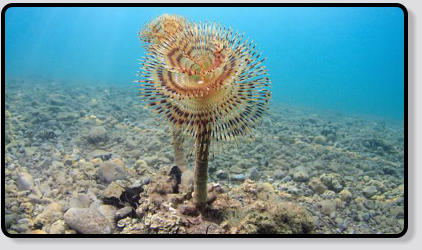
Sabella spallanzanii is a species of marine polychaete worms in the family Sabellidae. Common names include the Mediterranean fanworm, the
feather duster worm, the European fan worm and the pencil worm. It is native to shallow waters in the northeastern Atlantic Ocean and the
Mediterranean Sea. It has spread to various other parts of the world and is included on the Global Invasive Species Database.
The species' name commemorates the 18th-century biologist Lazzaro Spallanzani.
European fan worms grow to a total length of 9 to 40 cm (4 to 16 in) and are usually larger in deep water. They have stiff sandy tubes formed
from hardened mucus secreted by the worm which protrude from the sand, and a two-layered crown of feeding tentacles which can be retracted
into the tube. One of the layers forms a distinct spiral. The colour of the tentacles is variable but they are usually banded in orange, purple and
white or they may be a uniform pale grey. Various epiphytic organisms settle and grow on the tubes which may be rather wrinkled near their
bases.
The European fan worm is native to the northeastern Atlantic Ocean, the North Sea and the Mediterranean Sea. Its range extends from the
United Kingdom and Ireland, through France, Spain and Portugal to Italy, Greece and Turkey. It is also known from South America and the
southern African Namaqualand coast to Port Elizabeth.
Description
Animalia





Harry van Goor 2016
source: Wikipedia, the free encyclopedia


Categories: Worms





